Crispness, the Key for the Palatability of “Kakinotane”: A Sensory Study with Onomatopoeic Words
Abstract
1. Introduction
2. Experiment 1
2.1. Materials and Methods
2.1.1. Participants
2.1.2. Stimuli and Apparatus
2.1.3. Procedure
2.1.4. Data Analyses
2.2. Results
2.3. Discussion
3. Experiment 2
3.1. Materials and Methods
3.1.1. Participants
3.1.2. Stimuli and Apparatus
3.1.3. Procedure
3.1.4. Data Analyses
3.2. Results
3.3. Discussion
4. General Discussion
5. Conclusions
Author Contributions
Funding
Institutional Review Board Statement
Informed Consent Statement
Data Availability Statement
Conflicts of Interest
Appendix A
- BARI-BARI—A hard texture that requires force for mastication.
- PARI-PARI—A crumbly texture that requires less efforts for mastication, often used for describing potato chips.
- BORI-BORI—A hard and small texture, requiring force to masticate.
- PORI-PORI—A crispy, not too solid texture, not so difficult to masticate, such as crispy rice cookies.
- KARI-KARI—A texture between hardness and crumbliness that is easy to masticate.
- GARI-GARI—A hard texture being chewed into powder, providing great crispness and a sound while mastication.
- SAKU-SAKU—A soft and crumbly texture that is easy to masticate; a light feeling of crispness, often used for describing cookies.
- ZAKU-ZAKU—A fairly hard texture consisting of solid powder that results in a sound during mastication.
- SARA-SARA—A light texture, often associated with soups or a soft stewed rice.
- BETA-BETA—A very soft, moist, and sticky texture.
References
- Szczesniak, A.S. The meaning of textural characteristics-crispness. J. Texture Stud. 1988, 19, 51–59. [Google Scholar] [CrossRef]
- Tunick, M.H.; Onwulata, C.I.; Thomas, A.E.; Phillips, J.G.; Mukhopadhyay, S.; Sheen, S.; Liu, C.; Latona, N.; Pimentel, M.R.; Cooke, P.H. Critical evaluation of crispy and crunchy textures: A review. Int. J. Food Prop. 2013, 16, 949–963. [Google Scholar] [CrossRef]
- Katz, E.E.; Labuza, T.P. Effect of water activity on the sensory crispness and mechanical deformation of snack food products. J. Food Sci. 1981, 46, 403–409. [Google Scholar] [CrossRef]
- Seymour, S.K.; Hamann, D.D. Crispness and crunchiness of selected low moisture foods. J. Texture Stud. 1988, 19, 79–95. [Google Scholar] [CrossRef]
- Civille, G.V. Food texture: Pleasure and pain. J. Agric. Food Chem. 2011, 59, 1487–1490. [Google Scholar] [CrossRef]
- Guinard, J.X.; Mazzucchelli, R. The sensory perception of texture and mouthfeel. Trends Food Sci. Technol. 1996, 7, 213–219. [Google Scholar] [CrossRef]
- Wang, X.; Njehia, N.S.; Katsuno, N.; Nishizu, T. An acoustic study on the texture of cellular brittle foods. Rev. Agric. Sci. 2020, 8, 170–185. [Google Scholar] [CrossRef]
- Szczesniak, A.S. Psychorheology and texture as factors controlling the consumer acceptance of food. Cereal Foods World 1990, 35, 1201–1205. [Google Scholar]
- Pineau, N.; Schlich, P.; Cordelle, S.; Mathonnière, C.; Issanchou, S.; Imbert, A.; Rogeaux, M.; Etiévant, P.; Köster, E. Temporal dominance of sensations: Construction of the TDS curves and comparison with time-intensity. Food Qual. Prefer. 2009, 20, 450–455. [Google Scholar] [CrossRef]
- Hutchings, S.C.; Foster, K.D.; Hedderley, D.I.; Morgenstern, M.P. Differences between age groups in the use of the Temporal Dominance of Sensations technique across a range of food textures. J. Texture Stud. 2014, 45, 206–219. [Google Scholar] [CrossRef]
- Patterson, N.M.; Zhong, Y.; James, B.J.; Gant, N.; Hautus, M.J. Effect of basic structural variation, aimed at increasing perceivable textures in model foods, on the perception of textural complexity. Food Qual. Prefer. 2021, 91, 104196. [Google Scholar] [CrossRef]
- Nishinari, K.; Hayakawa, F.; Xia, C.F.; Huang, L.; Meullenet, J.F.; Sieffermann, J. Comparative study of texture terms: English, French, Japanese and Chinese. J. Texture Stud. 2008, 39, 530–568. [Google Scholar] [CrossRef]
- Arboleda, A.M.; Arce-Lopera, C. The French, German, and Spanish sound of eating fruits and vegetables. Food Res. Int. 2017, 102, 171–175. [Google Scholar] [CrossRef]
- Hayakawa, F.; Kazami, Y.; Nishinari, K.; Ioku, K.; Akuzawa, S.; Yamano, Y.; Baba, Y.; Kohyama, K. Classification of Japanese texture terms. J. Texture Stud. 2013, 44, 140–159. [Google Scholar] [CrossRef]
- Hayakawa, F.; Ioku, K.; Akuzawa, S.; Yoneda, C.; Kazami, Y.; Nishinari, K.; Baba, Y.; Kohyama, K. Research survey of Japanese consumers on texture vocabulary. Nippon Shokuhin Kagaku Kogaku Kaishi 2006, 53, 327–333. [Google Scholar] [CrossRef][Green Version]
- Yoshikawa, S.; Nishimaru, S.; Tashiro, T.; Yoshida, M. Collection and classification of words for description of food texture. J. Texture Stud. 1970, 1, 443–451. [Google Scholar] [CrossRef] [PubMed]
- Hanada, M. Food texture dimensions expressed by Japanese onomatopoeic words. J. Texture Stud. 2019, 51, 398–411. [Google Scholar] [CrossRef]
- Osaka, N. Walk-related mimic word activates the extrastriate visual cortex in the human brain: An fMRI study. Behav. Brain Res. 2009, 198, 186–189. [Google Scholar] [CrossRef]
- Arroyo, C.; Arboleda, A.M. Sonic food words influence the experience of beverage healthfulness. Food Qual. Prefer. 2021, 88, 104089. [Google Scholar] [CrossRef]
- Thomas, A.; Visalli, M.; Cordelle, S.; Schlich, P. Temporal drivers of liking. Food Qual. Prefer. 2015, 40, 365–375. [Google Scholar] [CrossRef]
- Langellier, B.A.; Brookmeyer, R.; Wang, M.C.; Glik, D. Language use affects food behaviours and food values among Mexican-origin adults in the USA. Public Health Nutr. 2015, 18, 264–274. [Google Scholar] [CrossRef]
- Zampini, M.; Spence, C. The role of auditory cues in modulating the perceived crispness and staleness of potato chips. J. Sens. Stud. 2004, 19, 347–363. [Google Scholar] [CrossRef]
- Thomas, A.; van der Stelt, A.J.; Prokop, J.; Lawlor, J.B.; Schlich, P. Alternating temporal dominance of sensations and liking scales during the intake of a full portion of an oral nutritional supplement. Food Qual. Prefer. 2016, 53, 159–167. [Google Scholar] [CrossRef]
- Lenfant, F.; Loret, C.; Pineau, N.; Hartmann, C.; Martin, N. Perception of oral food breakdown. The concept of sensory trajectory. Appetite 2009, 52, 659–667. [Google Scholar] [CrossRef] [PubMed]
- Sakamoto, M.; Watanabe, J. Cross-modal associations between sounds and drink tastes/textures: A study with spontaneous production of sound symbolic words. Chem. Senses 2016, 41, 197–203. [Google Scholar] [CrossRef] [PubMed]
- Lucas, P.W.; Ow, R.K.K.; Ritchie, G.M.; Chew, C.L.; Keng, S.B. Relationship between jaw movement and food breakdown in human mastication. J. Dent. Res. 1986, 65, 400–404. [Google Scholar] [CrossRef]
- Vickers, Z.M. Sensory, acoustical, and force-deformation measurements of potato chip crispness. J. Food Sci. 1987, 52, 138–140. [Google Scholar] [CrossRef]
- Vickers, Z.M. Instrumental measures of crispness and their correlation with sensory assessment. J. Texture Stud. 1988, 19, 1–14. [Google Scholar] [CrossRef]
- Endo, H.; Ino, S.; Fujisaki, W. The effect of a pseudo-chewing sound on perceived texture of softened foods. Physiol. Behav. 2016, 167, 324–331. [Google Scholar] [CrossRef]
- Endo, H.; Ino, S.; Fujisaki, W. Texture-dependent effects of pseudo-chewing sound on perceived food texture and evoked feelings in response to nursing care foods. Appetite 2017, 116, 493–501. [Google Scholar] [CrossRef]
- Luckett, C.R.; Meullenet, J.F.; Seo, H.S. Crispness level of potato chips affects temporal dynamics of flavor perception and mastication patterns in adults of different age groups. Food Qual. Prefer. 2016, 51, 8–19. [Google Scholar] [CrossRef]
- Wang, J.S.; Stohler, C.S. Predicting foodstuff from jaw dynamics during masticatory crushing in man. Arch. Oral Biol. 1991, 36, 239–244. [Google Scholar] [CrossRef]
- Dacremont, C. Spectral composition of eating sounds generated by crispy, crunchy and crackly foods. J. Texture Stud. 1995, 26, 27–43. [Google Scholar] [CrossRef]
- Çarşanba, E.; Duerrschmid, K.; Schleining, G. Assessment of acoustic-mechanical measurements for crispness of wafer products. J. Food Eng. 2018, 229, 3–101. [Google Scholar] [CrossRef]
- Gouyo, T.; Mestres, C.; Maraval, I.; Fontez, B.; Hofleitner, C.; Bohuon, P. Assessment of acoustic-mechanical measurements for texture of French fries: Comparison of deep-fat frying and air frying. Food Res. Int. 2020, 131, 108947. [Google Scholar] [CrossRef]
- Dacremont, C.; Colas, B.; Sauvageot, F. Contribution of air-and bone-conduction to the creation of sounds perceived during sensory evaluation of foods. J. Texture Stud. 1991, 22, 443–456. [Google Scholar] [CrossRef]
- Hashimoto, T.; Usui, N.; Taira, M.; Nose, I.; Haji, T.; Kojima, S. The neural mechanism associated with the processing of onomatopoeic sounds. Neuroimage 2006, 31, 1762–1770. [Google Scholar] [CrossRef] [PubMed]
- Sasamoto, R.; Jackson, R. Onomatopoeia—Showing-word or saying-word? Relevance theory, lexis, and the communication of impressions. Lingua 2016, 175–176, 36–53. [Google Scholar] [CrossRef]
- Demattè, M.L.; Pojer, N.; Endrizzi, I.; Corollaro, M.L.; Betta, E.; Aprea, E.; Charles, M.; Biasioli, F.; Zampini, M.; Gasperi, F. Effects of the sound of the bite on apple perceived crispness and hardness. Food Qual. Prefer. 2014, 38, 58–64. [Google Scholar] [CrossRef]
- Rodrigues, J.F.; de Souza, V.R.; Lima, R.R.; de Deus Souza Carneiro, J.; Nunes, C.A.; Pinheiro, A.C.M. Temporal dominance of sensations (TDS) panel behavior: A preliminary study with chocolate. Food Qual. Prefer. 2016, 54, 51–57. [Google Scholar] [CrossRef]
- Tanaka, M. Texture of Japanese foods. Food Rev. Int. 1986, 2, 247–265. [Google Scholar] [CrossRef]
- Murai, K.; Okimoto, K.; Matsuo, K.; Terada, Y. Study on masticatory movement and its ability: Efficacy of a test capsule in the evaluation of masticatory movement. J. Oral Rehabil. 2000, 27, 64–69. [Google Scholar] [CrossRef]
- Mioche, L.; Bourdiol, P.; Peyron, M.A. Influence of age on mastication: Effects on eating behaviour. Nutr. Res. Rev. 2004, 17, 43–54. [Google Scholar] [CrossRef]
- McKiernan, F.; Mattes, R.D. Effects of peanut processing on masticatory performance during variable appetitive states. Nutr. Metab. 2010, 2010, 487031. [Google Scholar] [CrossRef]
- Dijksterhuis, G.; Luyten, H.; de Wijk, R.; Mojet, J. A new sensory vocabulary for crisp and crunchy dry model foods. Food Qual. Prefer. 2007, 18, 37–50. [Google Scholar] [CrossRef]
- Varela, P.; Salvador, A.; Gámbaro, A.; Fiszman, S. Texture concepts for consumers: A better understanding of crispy-crunchy sensory perception. Eur. Food Res. Technol. 2008, 226, 1081–1090. [Google Scholar] [CrossRef]
- Winawer, J.; Witthoft, N.; Frank, M.C.; Wu, L.; Wade, A.R.; Boroditsky, L. Russian blues reveal effects of language on color discrimination. Proc. Natl. Acad. Sci. USA 2007, 104, 7780–7785. [Google Scholar] [CrossRef]
- Lupyan, G.; Spivey, M. Perceptual processing is facilitated by ascribing meaning to novel stimuli. Curr. Biol. 2008, 18, R410–R412. [Google Scholar] [CrossRef] [PubMed]
- Miller, T.M.; Schmidt, T.T.; Blankenburg, F.; Pulvermuller, F. Verbal labels facilitate tactile perception. Cognition 2018, 171, 172–179. [Google Scholar] [CrossRef]
- Iwasaki, N.; Vinson, D.P.; Vigliocco, G. How does it hurt, kiri-kiri or siku-siku? Japanese mimetic words of pain perceived by Japanese speakers and English speakers. In Applying Theory and Research to Learning Japanese as a Foreign Language; Minami, M., Ed.; Cambridge Scholars Publishing: Newcastle, UK, 2007; pp. 2–19. [Google Scholar]
- Willems, R.M.; Frank, S.L.; Nijhof, A.D.; Hagoort, P.; van den Bosch, A. Prediction during natural language comprehension. Cereb. Cortex 2016, 26, 2506–2516. [Google Scholar] [CrossRef]
- Ma, Q. Cognitive Mechanisms on Japanese Onomatopoeia of Pain (Nihongo No Itami No Onomatope No Ninchi Kiban). Ph.D. Thesis, Tohoku University, Sendai, Japan, 2021. [Google Scholar]
- Yorkston, E.A.; Menon, G.A. Sound idea: Phonetic effects on brand names on consumer judgments. J. Consum. Res. 2004, 31, 43–51. [Google Scholar] [CrossRef]
- Alameer, A. The linguistic features of onomatopoeia words in Arabic-English: Contrastive study. Int. J. Hum. Soc. Stud. Invent. 2019, 8, 6–12. [Google Scholar]
- Alyeh, K.; Zeinolabedin, R. A comparison between onomatopoeia and sound symbolism in Persian and English and their application in the discourse of advertisements. Int. J. Basic Sci. Appl. Res. 2014, 3, 219–225. [Google Scholar]



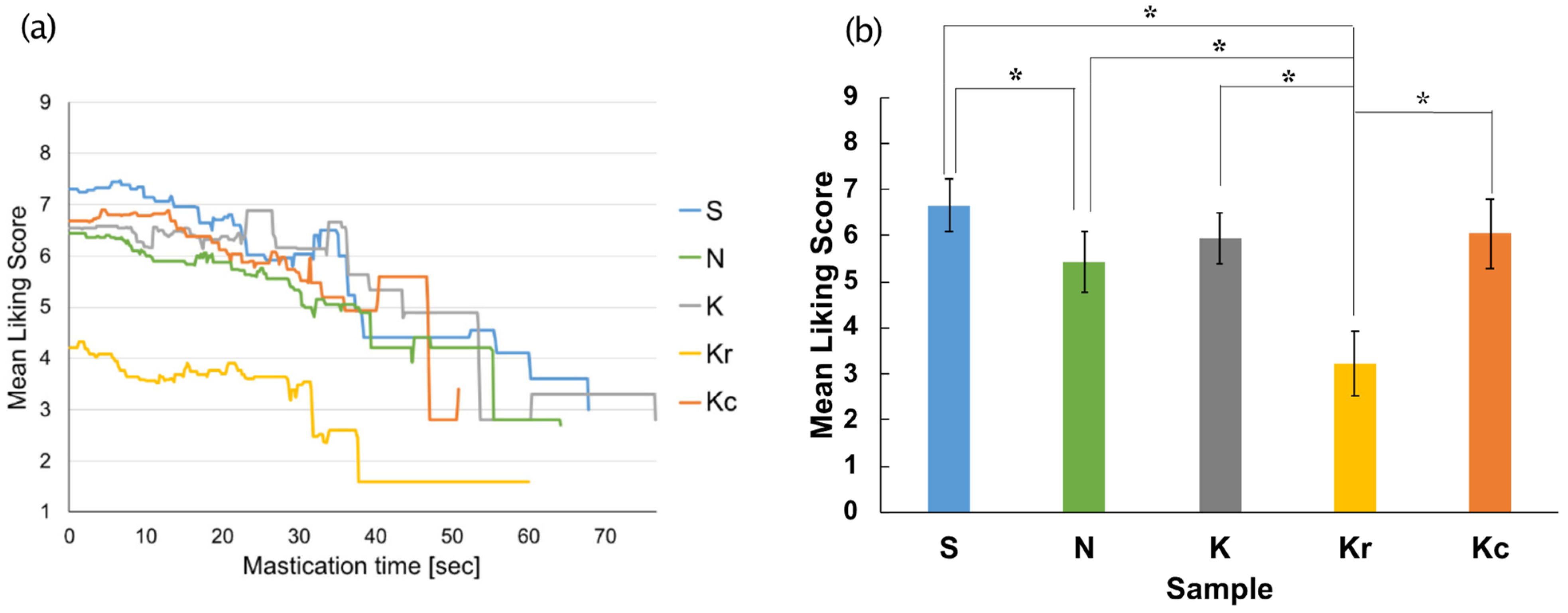
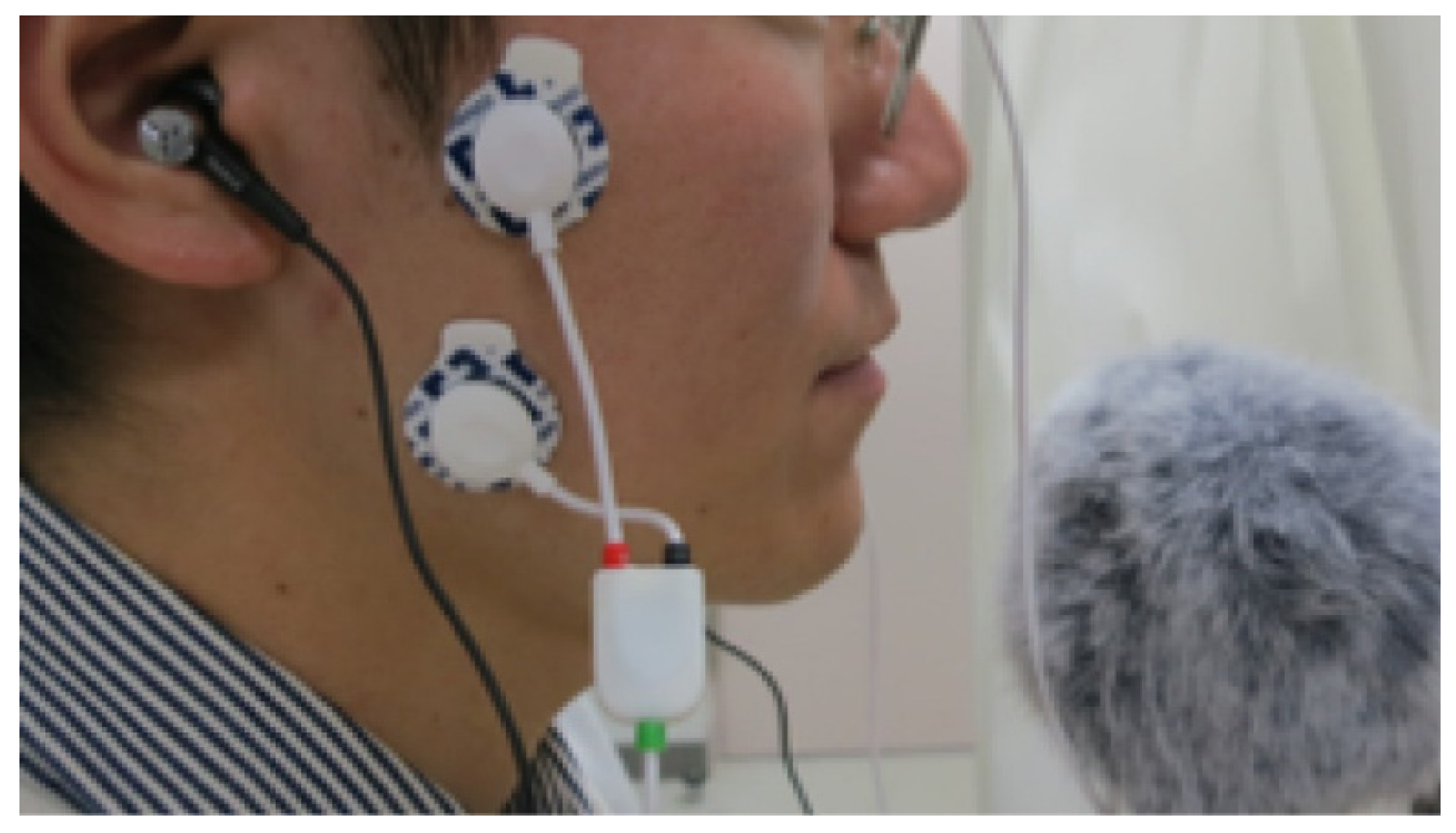
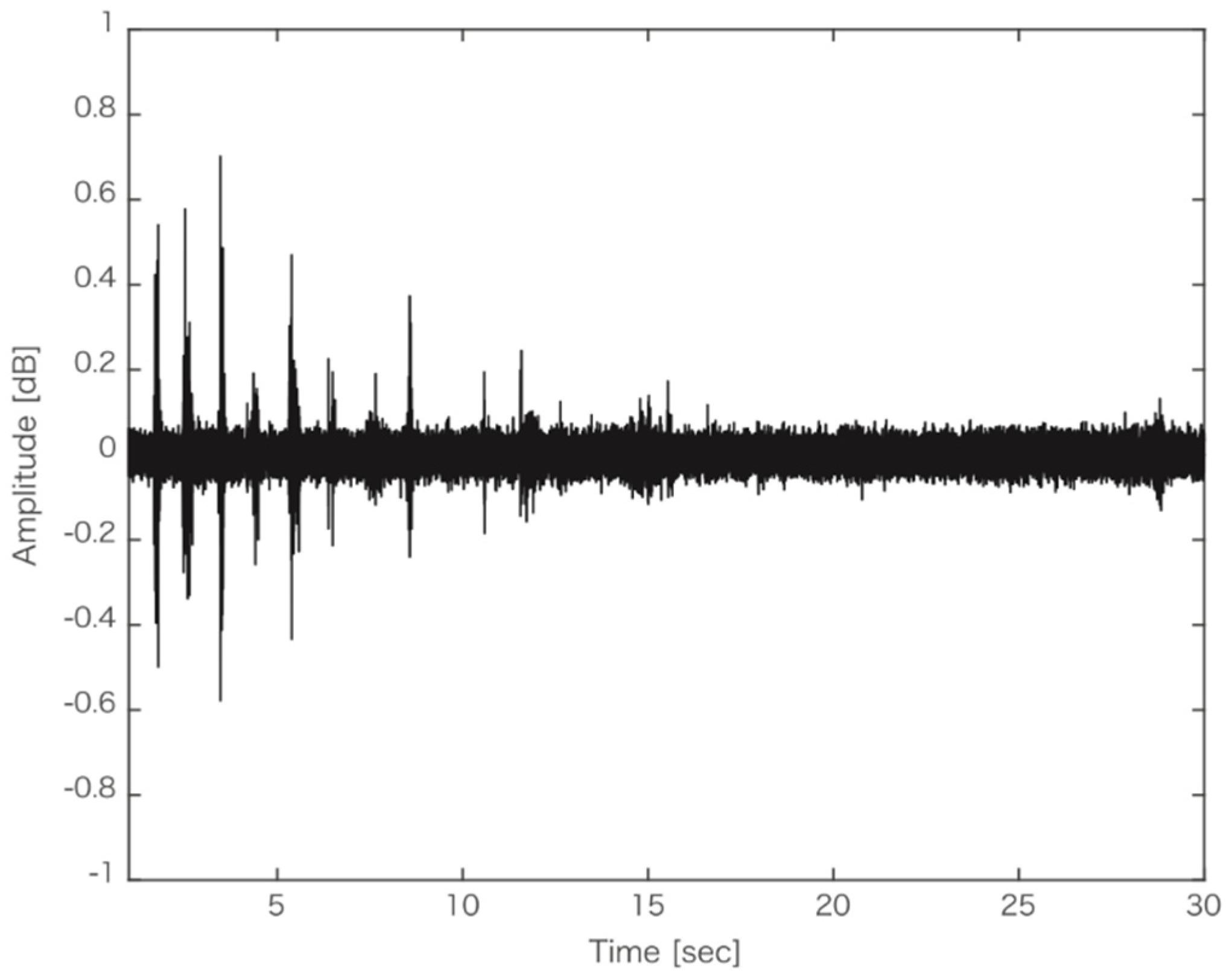
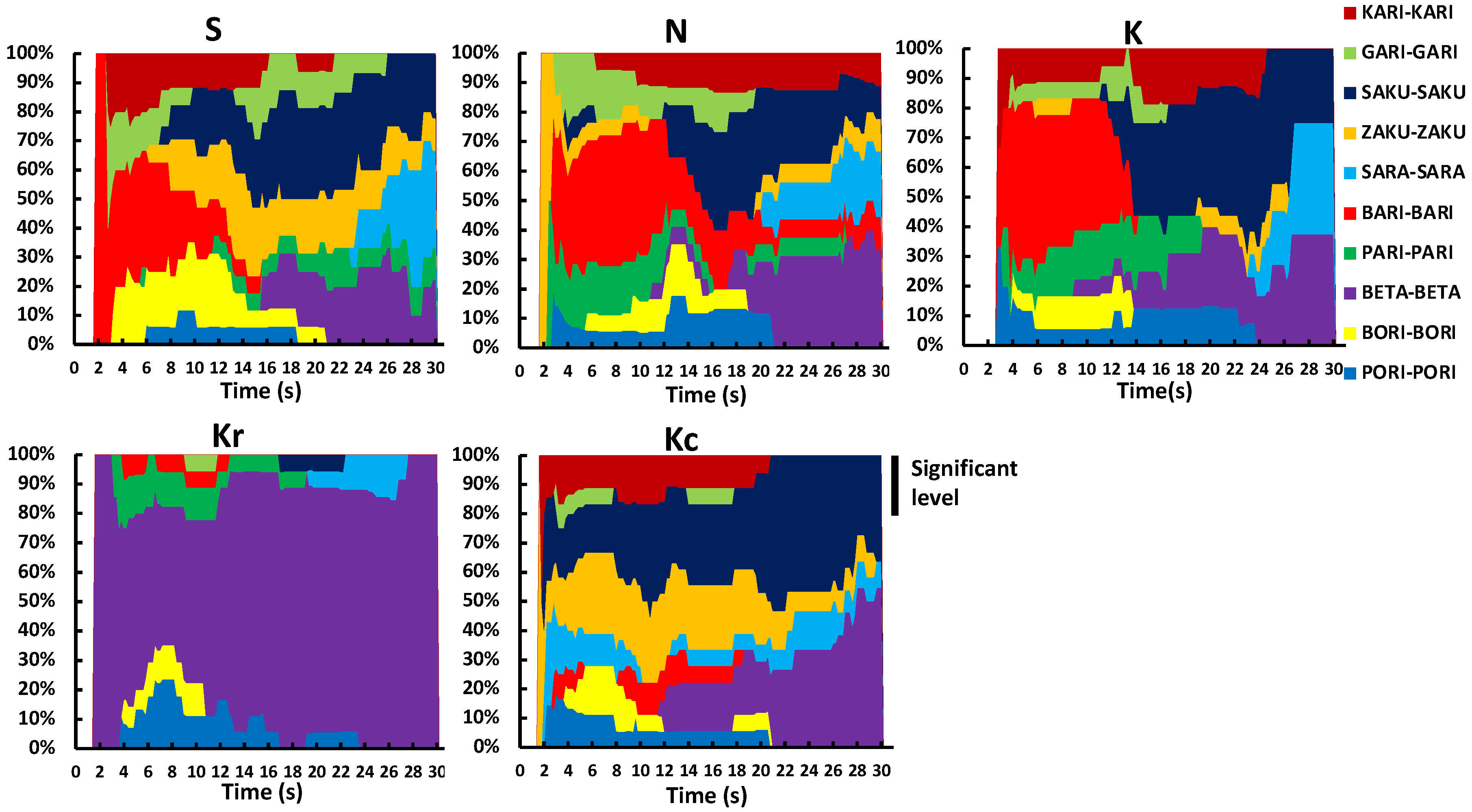

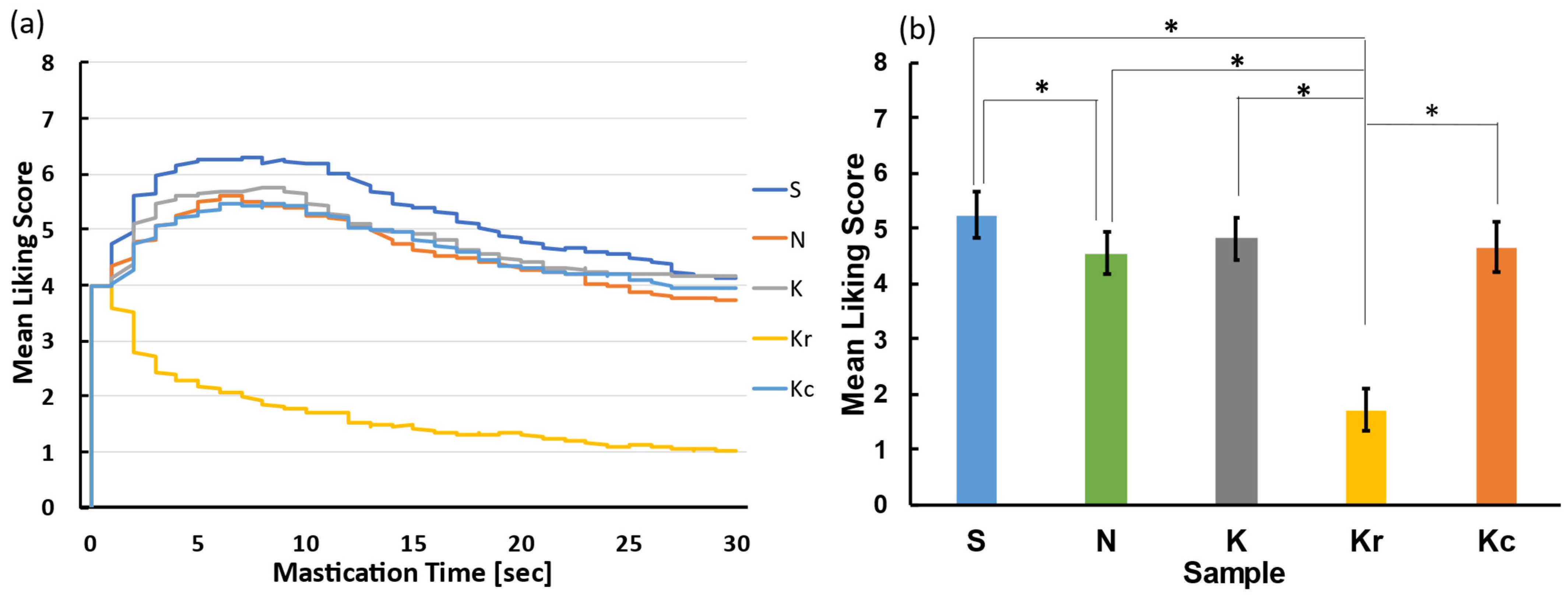
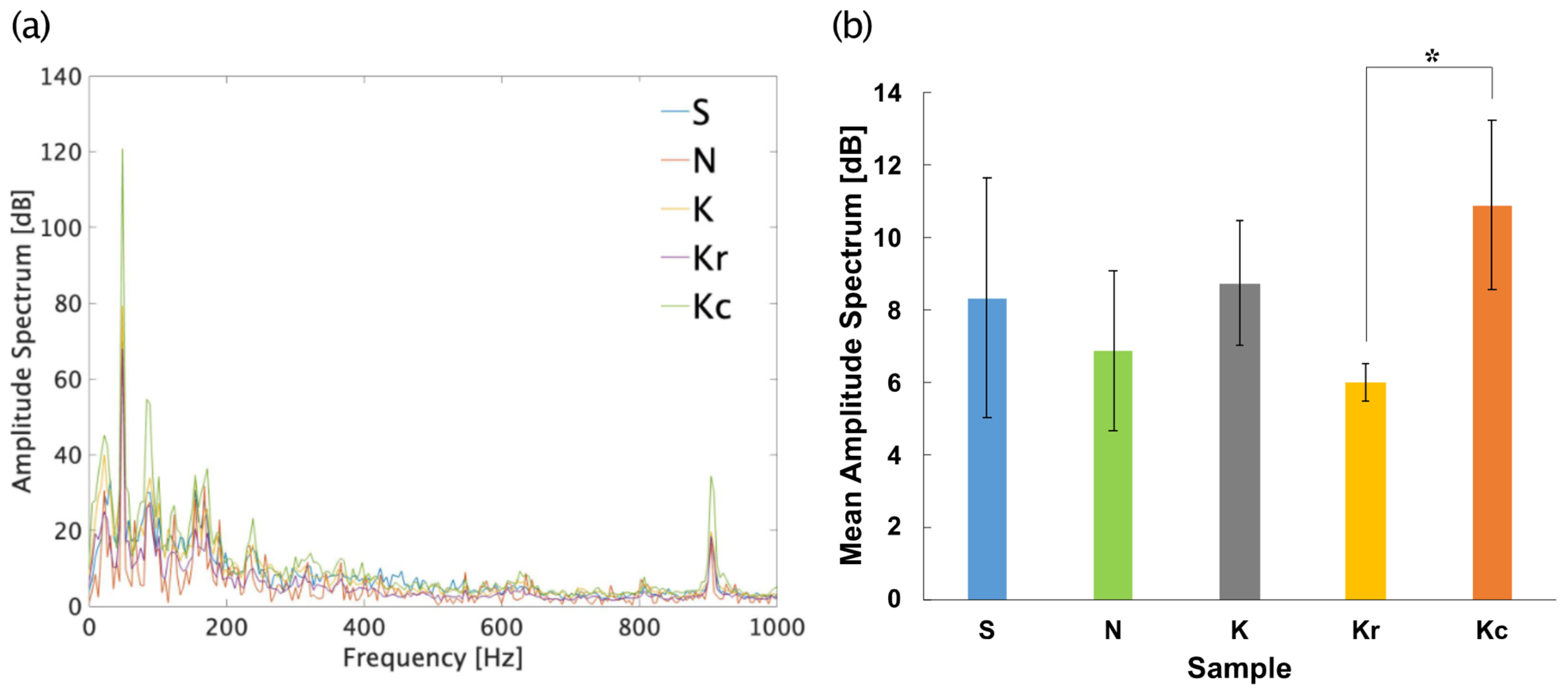


| S | N | K | Kr | Kc | |
|---|---|---|---|---|---|
| KARI-KARI | 0.194 (2) | 0.182 (2) | 0.071 (2) | −0.076 (1) | 0.178 (3) |
| GARI-GARI | - | −0.031 (1) | −0.009 (3) | 0.198 (2) | 0.075 (1) |
| SAKU-SAKU | −0.177 (3) | −0.101 (1) | - | - | 0.163 (3) |
| ZAKU-ZAKU | 0.171 (1) | 0.029 (2) | −0.215 (4) | - | −0.179 (2) |
| SARA-SARA | - | −0.139 (1) | - | - | −0.140 (1) |
| BARI-BARI | 0.122 (3) | 0.181 (2) | - | - | - |
| PARI-PARI | 0.015 (1) | 0.074 (2) | −0.146 (1) | - | - |
| BETA-BETA | −0.094 (4) | - | −0.190 (1) | - | |
| BORI-BORI | −0.001 (3) | −0.013 (2) | −0.048 (2) | 0.068 (2) | 0.047 (3) |
| PORI-PORI | −0.231 (3) | −0.182 (2) | 0.347 (2) | - | −0.145 (2) |
| S | N | K | Kr | Kc | |
|---|---|---|---|---|---|
| KARI-KARI | 0.045 (3) | 0.015 (2) | −0.063 (3) | - | −0.012 (1) |
| GARI-GARI | 0.041 (6) | 0.056 (4) | −0.045 (2) | - | 0.069 (2) |
| SAKU-SAKU | −0.091 (10) | −0.118 (6) | −0.045 (6) | - | 0.091 (11) |
| ZAKU-ZAKU | 0.107 (4) | −0.049 (1) | 0.023 (2) | - | 0.169 (9) |
| SARA-SARA | −0.209 (5) | −0.161 (4) | −0.248 * (4) | −0.025 (1) | −0.072 (5) |
| BARI-BARI | 0.208 * (5) | 0.365 * (8) | 0.406 * (10) | 0.036 (2) | 0.089 (3) |
| PARI-PARI | 0.015 (2) | 0.057 (4) | 0.067 (4) | 0.062 (2) | - |
| BETA-BETA | −0.257 * (6) | −0.328 * (7) | −0.253 * (7) | −0.128 * (9) | −0.444 * (8) |
| BORI-BORI | 0.117 * (5) | 0.117 (3) | 0.079 (2) | 0.050 (3) | 0.091 (4) |
| PORI-PORI | 0.024 (3) | 0.047 (3) | 0.079 (4) | 0.006 (4) | 0.019 (3) |
Publisher’s Note: MDPI stays neutral with regard to jurisdictional claims in published maps and institutional affiliations. |
© 2021 by the authors. Licensee MDPI, Basel, Switzerland. This article is an open access article distributed under the terms and conditions of the Creative Commons Attribution (CC BY) license (https://creativecommons.org/licenses/by/4.0/).
Share and Cite
Saita, A.; Yamamoto, K.; Raevskiy, A.; Takei, R.; Washio, H.; Shioiri, S.; Sakai, N. Crispness, the Key for the Palatability of “Kakinotane”: A Sensory Study with Onomatopoeic Words. Foods 2021, 10, 1724. https://doi.org/10.3390/foods10081724
Saita A, Yamamoto K, Raevskiy A, Takei R, Washio H, Shioiri S, Sakai N. Crispness, the Key for the Palatability of “Kakinotane”: A Sensory Study with Onomatopoeic Words. Foods. 2021; 10(8):1724. https://doi.org/10.3390/foods10081724
Chicago/Turabian StyleSaita, Atsuhiro, Kosuke Yamamoto, Alexander Raevskiy, Ryo Takei, Hideaki Washio, Satoshi Shioiri, and Nobuyuki Sakai. 2021. "Crispness, the Key for the Palatability of “Kakinotane”: A Sensory Study with Onomatopoeic Words" Foods 10, no. 8: 1724. https://doi.org/10.3390/foods10081724
APA StyleSaita, A., Yamamoto, K., Raevskiy, A., Takei, R., Washio, H., Shioiri, S., & Sakai, N. (2021). Crispness, the Key for the Palatability of “Kakinotane”: A Sensory Study with Onomatopoeic Words. Foods, 10(8), 1724. https://doi.org/10.3390/foods10081724








